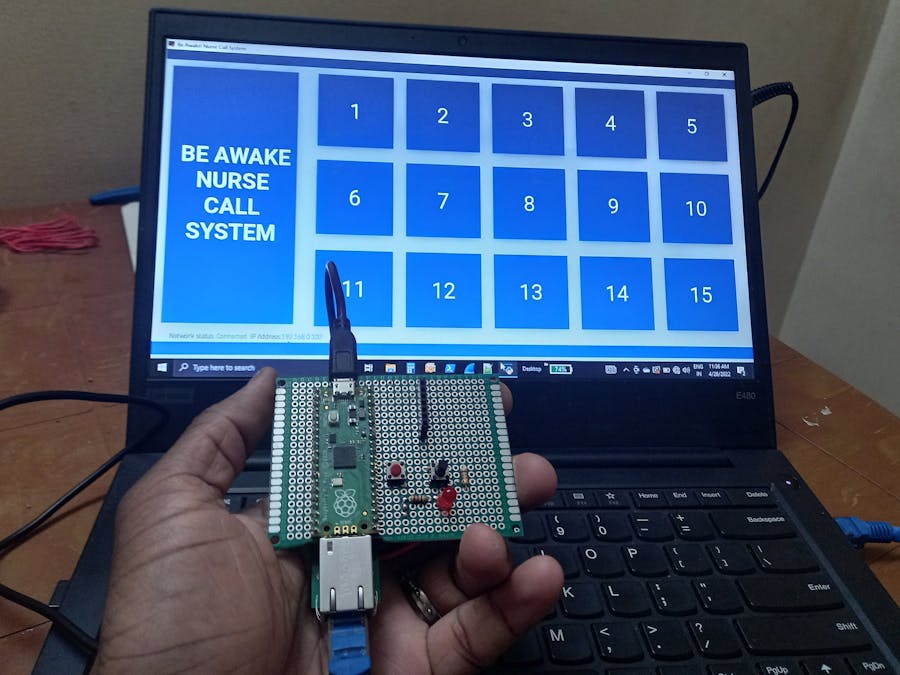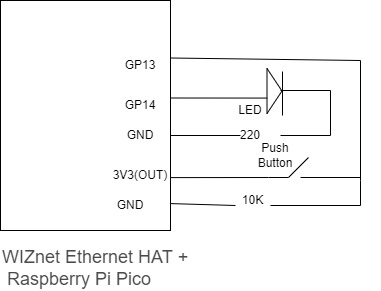Be Awake ! IP Hardwired Nurse Call System
A Modern Ethernet based nurse call system Solution.
OverviewThis system helps in emergencies that can be presented to patients in hospitals, clinics, nurse homes and other institution where sick people are hospitalized.
When a patient press the button, the system updates the status on the windows application that a patient from specific room number is calling.Each Device has a unique identification number in the system. In order to turn off the call, nurse or patient can press the same button.
The firmware on Raspberry Pi Pico implements SPI Communication with WIZnet Ethernet HAT module and writes UDP data to the remote receiver(Windows Application).
Features:
- Every call-points include call and cancel/acknowledge button.
- Instant communication with a nurse call system. Relevant staff can be contacted immediately.
- any Patient call is remembered until the patient is attended to
- Alerts can be viewed from the nurses room by means of Desktop Application.
- Can work on existing LAN network of hospitals.
The Idea:
I had an idea of building nurse calling system in my ideas bucket list from several months. I'm a firmware engineer by profession. I had seen lot of cool projects using Raspberry Pi Pico and I had never used it. As part of Work, in the Mid of January I was on site for one of our project and I had to work with WIZnet W5500 series of Ethernet chips. During that time I heard about Wiznet Ethernet HATcontest 2022, and I decided to make my idea into reality.
- WIZnet Ethernet HAT
WIZnet Ethernet HAT (Hardware Attached on Top) is a Raspberry Pi Pico pin-compatible board that utilizes W5100S and supports both 3.3V & 5V.
Please refer to this link to find more information about W5100S.
- Raspberry Pi Pico Pin-Compatible
- Ethernet (W5100S Hardwired TCP/IP CHIP)
- Product page : https://docs.wiznet.io/Product/iEthernet/W5100S/overview
- Support 4 Independent Hardware SOCKETs simultaneously
- Support SOCKET-less new Command: ARP-Request, PING-Request
- Support Auto-MDIX only when Auto-Negotiation mode
- Raspberry Pi Pico
Raspberry Pi Pico is a tiny, fast, and versatile board built using RP2040, a brand new microcontroller chip designed by Raspberry Pi
A guide to combining pico with WIZnet ethernet hat is available from this glimpse video which I made during initial stage of this project.
- A router that offers DHCP services.
- Push Button
- LED
- Current limit resistors
Raspberry Pi Pico Pinout
Hardware Connection:
1.Combine WIZnet Ethernet HAT with Raspberry Pi Pico.
2. Connect ethernet cable one side to Ethernet HAT ethernet port. Connect other side to Router's Port.
3. Connect Raspberry Pi Pico to desktop or laptop using 5 pin micro USB cable
4. Connect One side of Push Button to GP13 of pico and other side to 3V3. Add a Pull Down resistor of 10Kohm(Refer above image).
5. Connect LED in between pico's GP14 and GND.
Debugging:
Installing firmware on Pico is really simple.
Press (and keep pressed) the BOOTSEL button on board:
With this button pressed, please plug in the USB cable to Pico and to your computer. It will see the board as removable storage.
But, Plugging in and out.....
But later removing USB cable for installing firmware has become a headache for me During firmware development and debugging. So I added a a push button to do it easily.
Also I added a USB to TTL Converter in-between UART0TX(GP0) and GND to print out debug message. It really helped me to debug during firmware development.
Some snaps from development stage....
Windows Application:
I had this idea of making a IP hardwired nurse calling system, and I wanted to give a name for it. So I just messaged people close to me to suggest some names for it.
And My Aunt Came up with the name "Be Awake". And the interesting thing is, she is Nursing tutor by profession.
Working:
- At normal condition, In the PC application, Room section will be in blue Color.
- Whenever patient presses emergency button, the corresponding room number becomes red in color.
Download Windows Application executable:
References:
- https://datasheets.raspberrypi.com/pico/getting-started-with-pico.pdf
- https://raspberrypi.github.io/pico-sdk-doxygen/index.html
- https://github.com/Wiznet/pico-loopback-result
- https://github.com/Wiznet/W5100S-EVB/tree/master/DHCPClient/src
- https://docs.wiznet.io/Product/iEthernet/W5100S/Application-Note/udp
- https://docs.wiznet.io/Product/iEthernet/W5100S/driver




















_3u05Tpwasz.png?auto=compress%2Cformat&w=40&h=40&fit=fillmax&bg=fff&dpr=2)
Comments
Please log in or sign up to comment.